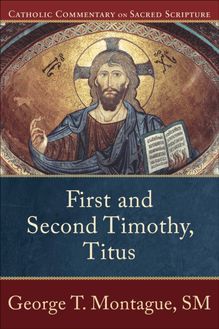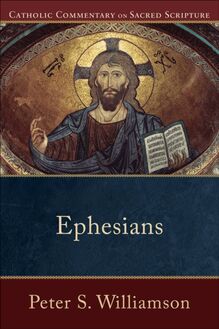-
 Univers
Univers
-
 Ebooks
Ebooks
-
 Livres audio
Livres audio
-
 Presse
Presse
-
 Podcasts
Podcasts
-
 BD
BD
-
 Documents
Documents
-
- Cours
- Révisions
- Ressources pédagogiques
- Sciences de l’éducation
- Manuels scolaires
- Langues
- Travaux de classe
- Annales de BEP
- Etudes supérieures
- Maternelle et primaire
- Fiches de lecture
- Orientation scolaire
- Méthodologie
- Corrigés de devoir
- Annales d’examens et concours
- Annales du bac
- Annales du brevet
- Rapports de stage
La lecture à portée de main
Vous pourrez modifier la taille du texte de cet ouvrage
Découvre YouScribe en t'inscrivant gratuitement
Je m'inscrisActs of the Apostles (Catholic Commentary on Sacred Scripture) , livre ebook
Découvre YouScribe en t'inscrivant gratuitement
Je m'inscrisEn savoir plus
Vous pourrez modifier la taille du texte de cet ouvrage
En savoir plus

Description
Sujets
Informations
| Publié par | Baker Publishing Group |
| Date de parution | 18 février 2014 |
| Nombre de lectures | 0 |
| EAN13 | 9781441244703 |
| Langue | English |
| Poids de l'ouvrage | 4 Mo |
Informations légales : prix de location à la page 0,0720€. Cette information est donnée uniquement à titre indicatif conformément à la législation en vigueur.
Extrait
Series Page
Catholic Commentary on Sacred Scripture
S ERIES E DITORS
Peter S. Williamson
Mary Healy
A SSOCIATE E DITOR
Kevin Perrotta
C ONSULTING E DITORS
Scott Hahn , Franciscan University of Steubenville
†Daniel J. Harrington, SJ , Weston Jesuit School of Theology
William S. Kurz, SJ , Marquette University
†Francis Martin , Dominican House of Studies
Frank J. Matera , Catholic University of America
George Montague, SM , St. Mary’s University
Terrence Prendergast, SJ , Archbishop of Ottawa
© 2013 by William S. Kurz, SJ
Published by Baker Academic
a division of Baker Publishing Group
P.O. Box 6287, Grand Rapids, MI 49516-6287
www.bakeracademic.com
Ebook edition created 2014
Ebook corrections 06.28.2018, 10.01.2018
All rights reserved. No part of this publication may be reproduced, stored in a retrieval system, or transmitted in any form or by any means—for example, electronic, photocopy, recording—without the prior written permission of the publisher. The only exceptions are brief quotations in printed reviews.
Library of Congress Cataloging-in-Publication Data is on file at the Library of Congress, Washington, DC.
ISBN 978-1-4412-4470-3
Nihil obstat:
Dr. Patrick Russell
Censor librorum
Imprimatur:
Most Rev. Jerome E. Listecki
Archbishop of Milwaukee
May 10, 2013
The nihil obstat and imprimatur are official declarations that a book or pamphlet is free of doctrinal or moral error. There is no implication that those who have granted the nihil obstat or the imprimatur agree with the content, opinions, or statements expressed therein.
Scripture quotations are from the New American Bible, Revised Edition © 1970, 1986, 1991, 2011 Confraternity of Christian Doctrine, Washington, DC, and are used by permission of the copyright owner. All rights reserved. No part of the New American Bible may be reproduced in any form without permission in writing from the copyright owner.
Unless otherwise indicated, all photos, illustrations and maps are copyright © Baker Photo Archive.
Contents
Cover
Series Page
Title Page
Copyright Page
Illustrations
Editors’ Preface
Abbreviations
Introduction
Outline of Acts
Luke’s Introduction to Acts (Acts 1:1–11)
Prayer in the Upper Room (Acts 1:12–26)
The Coming of the Holy Spirit and the Birth of the Church (Acts 2)
Healing Spurs the Growth of the Church (Acts 3:1–4:4)
Bold Testimony and a New Outpouring of the Spirit (Acts 4:5–31)
Sharing of Goods: Two Contrary Examples (Acts 4:32–5:11)
Signs and Wonders and Trials (Acts 5:12–42)
The Ordination of the Seven and the Preaching of Stephen (Acts 6:1–15)
Stephen’s Overview of Biblical History (Acts 7:1–53)
Martyrdom, Persecution, and Mission (Acts 7:54–8:40)
Paul’s Conversion and Baptism (Acts 9:1–22)
Saul’s Escape; Peter’s Healing of Aeneas and Tabitha (Acts 9:23–43)
The Conversion of Cornelius (Acts 10:1–11:18)
Church Growth at Antioch; Peter’s Escape (Acts 11:19–12:24)
The Mission of Barnabas and Saul (Acts 12:25–13:52)
Paul in Asia Minor: Iconium, Lystra, Derbe (Acts 14:1–28)
The Jerusalem Council (Acts 15:1–35)
The Separation of Paul and Barnabas (Acts 15:36–16:15)
Imprisonment and Release at Philippi (Acts 16:16–40)
Paul in Thessalonica, Beroea, and Athens (Acts 17:1–34)
Paul’s Mission in Corinth (Acts 18:1–28)
Ephesus (Acts 19:1–41)
Paul the Itinerant Pastor (Acts 20:1–16)
Paul’s Farewell Speech (Acts 20:17–38)
Paul’s Journey to Jerusalem (Acts 21:1–26)
Paul’s Arrest and Defense (Acts 21:27–23:35)
Trials before Roman Governors (Acts 24:1–25:12)
Paul before Agrippa (Acts 25:13–26:32)
Shipwreck en Route to Rome (Acts 27:1–44)
From Malta to Rome (Acts 28:1–16)
Testimony in Rome (Acts 28:17–31)
Suggested Resources
Glossary
Index of Pastoral Topics
Index of Sidebars
Notes
Back Cover
Illustrations
Figure 1. Jerusalem, Judea, Samaria (Acts 1:8)
Figure 2. Pentecost, Rabbula Gospels
Figure 3. Nations of Pentecost
Figure 4. Temple diagram
Figure 5. Solomon’s Portico
Figure 6. Temple model
Figure 7. Isaiah Scroll
Figure 8. Mosaic of St. Paul
Figure 9. Baptism of Cornelius
Figure 10. Roman sailing vessel
Figure 11. Paul’s first missionary journey
Figure 12. Garlanded bull
Figure 13. Paul’s second missionary journey
Figure 14. Jail in Philippi
Figure 15. Parthenon
Figure 16. Tribunal at Corinth
Figure 17. Paul’s third missionary journey
Figure 18. Artemis of Ephesus
Figure 19. Theater at Ephesus
Figure 20. First-century mikvah
Figure 21. Roman aqueduct
Figure 22. Roman emperor Nero
Figure 23. Paul’s voyage to Rome
Figure 24. St. Paul’s Bay, Malta
Editors’ Preface
The Church has always venerated the divine Scriptures just as she venerates the body of the Lord. . . . All the preaching of the Church should be nourished and governed by Sacred Scripture. For in the sacred books, the Father who is in heaven meets His children with great love and speaks with them; and the power and goodness in the word of God is so great that it stands as the support and energy of the Church, the strength of faith for her sons and daughters, the food of the soul, a pure and perennial fountain of spiritual life.
Second Vatican Council, Dei Verbum 21
Were not our hearts burning [within us] while he spoke to us on the way and opened the scriptures to us?
Luke 24:32
The Catholic Commentary on Sacred Scripture aims to serve the ministry of the Word of God in the life and mission of the Church. Since Vatican Council II, there has been an increasing hunger among Catholics to study Scripture in depth and in a way that reveals its relationship to liturgy, evangelization, catechesis, theology, and personal and communal life. This series responds to that desire by providing accessible yet substantive commentary on each book of the New Testament, drawn from the best of contemporary biblical scholarship as well as the rich treasury of the Church’s tradition. These volumes seek to offer scholarship illumined by faith, in the conviction that the ultimate aim of biblical interpretation is to discover what God has revealed and is still speaking through the sacred text. Central to our approach are the principles taught by Vatican II: first, the use of historical and literary methods to discern what the biblical authors intended to express; second, prayerful theological reflection to understand the sacred text “in accord with the same Spirit by whom it was written”—that is, in light of the content and unity of the whole Scripture, the living tradition of the Church, and the analogy of faith ( Dei Verbum 12).
The Catholic Commentary on Sacred Scripture is written for those engaged in or training for pastoral ministry and others interested in studying Scripture to understand their faith more deeply, to nourish their spiritual life, or to share the good news with others. With this in mind, the authors focus on the meaning of the text for faith and life rather than on the technical questions that occupy scholars, and they explain the Bible in ordinary language that does not require translation for preaching and catechesis. Although this series is written from the perspective of Catholic faith, its authors draw on the interpretation of Protestant and Orthodox scholars and hope these volumes will serve Christians of other traditions as well.
A variety of features are designed to make the commentary as useful as possible. Each volume includes the biblical text of the New American Bible Revised Edition (NABRE), the translation approved for liturgical use in the United States. In order to serve readers who use other translations, the most important differences between the NABRE and other widely used translations (RSV, NRSV, JB, NJB, and NIV) are noted and explained. Each unit of the biblical text is followed by a list of references to relevant Scripture passages, Catechism sections, and uses in the Roman Lectionary. The exegesis that follows aims to explain in a clear and engaging way the meaning of the text in its original historical context as well as its perennial meaning for Christians. Reflection and Application sections help readers apply Scripture to Christian life today by responding to questions that the text raises, offering spiritual interpretations drawn from Christian tradition, or providing suggestions for the use of the biblical text in catechesis, preaching, or other forms of pastoral ministry.
Interspersed throughout the commentary are Biblical Background sidebars that present historical, literary, or theological information, and Living Tradition sidebars that offer pertinent material from the postbiblical Christian tradition, including quotations from Church documents and from the writings of saints and Church Fathers. The Biblical Background sidebars are indicated by a photo of urns that were excavated in Jerusalem, signifying the importance of historical study in understanding the sacred text. The Living Tradition sidebars are indicated by an image of Eadwine, a twelfth-century monk and scribe, signifying the growth in the Church’s understanding that comes by the grace of the Holy Spirit as believers study and ponder the Word of God in their hearts (see Dei Verbum 8).
A map and a Glossary are located in the back of each volume for easy reference. The glossary explains key terms from the biblical text as well as theological or exegetical terms, which are marked in the commentary with a cross ( † ). A list of Suggested Resources, an Index of Pastoral Topics, and an Index of Sidebars are included to enhance the usefulness of these volumes. Further resources, including questions for reflection or discussion, can be found at the series website, www.CatholicScriptureCommentary.com.
It is our desire and prayer that these volumes be of service so that more and more “the word of the Lord may speed forward and be glorified” (2 Thess 3:1) in the Church and throughout the world.
Peter S. Willia
-
 Univers
Univers
-
 Ebooks
Ebooks
-
 Livres audio
Livres audio
-
 Presse
Presse
-
 Podcasts
Podcasts
-
 BD
BD
-
 Documents
Documents
-
Jeunesse
-
Littérature
-
Ressources professionnelles
-
Santé et bien-être
-
Savoirs
-
Education
-
Loisirs et hobbies
-
Art, musique et cinéma
-
Actualité et débat de société
-
Jeunesse
-
Littérature
-
Ressources professionnelles
-
Santé et bien-être
-
Savoirs
-
Education
-
Loisirs et hobbies
-
Art, musique et cinéma
-
Actualité et débat de société
-
Actualités
-
Lifestyle
-
Presse jeunesse
-
Presse professionnelle
-
Pratique
-
Presse sportive
-
Presse internationale
-
Culture & Médias
-
Action et Aventures
-
Science-fiction et Fantasy
-
Société
-
Jeunesse
-
Littérature
-
Ressources professionnelles
-
Santé et bien-être
-
Savoirs
-
Education
-
Loisirs et hobbies
-
Art, musique et cinéma
-
Actualité et débat de société
- Cours
- Révisions
- Ressources pédagogiques
- Sciences de l’éducation
- Manuels scolaires
- Langues
- Travaux de classe
- Annales de BEP
- Etudes supérieures
- Maternelle et primaire
- Fiches de lecture
- Orientation scolaire
- Méthodologie
- Corrigés de devoir
- Annales d’examens et concours
- Annales du bac
- Annales du brevet
- Rapports de stage




















